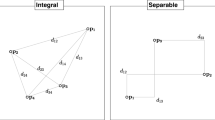Abstract
The usual methods of combining observations to give interpoint distance estimates based on interstimulus differences are shown to lead to a distortion of the stimulus configuration unless all individuals in a group perceive the stimuli in perceptual spaces which are essentially the same. The nature of the expected distortion is shown, and a method of combining individual distance estimates which produces only a linear deformation of the stimulus configuration is given.
Similar content being viewed by others
References
Attneave, F. Dimensions of similarity.American Journal of Psychology, 1950,63, 516–556.
Bennett, J. F., & Hays, W. L. Multidimensional unfolding: Determining the dimensionality of ranked preference data.Psychometrika, 1960,25, 27–44.
Coombs, C. H.A theory of data. New York: Wiley, 1964.
Coombs, C. H., & Kao, R. C. On a connection between factor analysis and multidimensional unfolding.Psychometrika, 1960,25, 219–231.
Eckart, C. T., & Young, G. The approximation of one matrix by another of lower rank.Psychometrika, 1936,1, 211–218.
Hays, W. L., & Bennett, J. F. Multidimensional unfolding: Determining configuration from complete rank order preference data.Psychometrika, 1961,26, 221–238.
Helm, C. E. A multidimensional ratio scaling analysis of color relations. O. N. R. Technical Report, Princeton University, 1959.
Helm, C. E. A succesive intervals analysis of color differences. O. N. R. Technical Report, Princeton University, 1960.
Helm, C. E., & Tucker, L. R. Individual differences in the structure of color-perception.American Journal of Psychology, 1962,75, 437–444.
Indow, T., & Kanazawa, K. Multidimensional mapping of Munsell colors varying in hue, chroma, and value.Journal of Experimental Psychology, 1960,59, 330–336.
Indow, T., & Uchizono, T. Multidimensional mapping of Munsell colors varying in hue and chroma.Journal of Experimental Psychology, 1960,59, 321–329.
Kruskal, J. B. Multidimensional scaling by optimizing goodness of fit to a nonmetric hypothesis.Psychometrika, 1964,29, 1–28.
Messick, S. An empirical evaluation of multidimensional successive intervals.Psychometrika, 1956,21, 367–375.
Messick, S. The perceived structure of political relationships.Sociometry, 1961,24, 270–278.
Messick, S., & Abelson, R. P. The additive constant problem in multidimensional scaling.Psychometrika, 1956,21, 1–17.
Moore, D. W., & Ross, J. A fast principal components factor analysis program for the IBM 1620.Educational and Psychological Measurement, 1964,24, 675–676.
Shepard, R. N. Stimulus and response generalization: Tests of a model relating generalization to distance in psychological space.Journal of Experimental Psychology, 1958,55, 509–523.
Shepard, R. N. The analysis of proximities: Multidimensional scaling with an unknown distance function. I.Psychometrika, 1962,27, 125–140. (a)
Shepard, R. N. The analysis of proximities: Multidimensional scaling with an unknown distance function. II.Psychometrika, 1962,27, 219–246. (b)
Shepard, R. N. Attention and the metric structure of the stimulus space.Journal of Mathematical Psychology, 1964,1, 54–87.
Torgerson, W. S. Multidimensional scaling I: Theory and method.Psychometrika, 1952,17, 401–419.
Torgerson, W. S.Theory and methods of scaling. N. Y.: Wiley, 1958.
Tucker, L. R., & Messick, S. An individual differences model for multidimensional scaling.Psychometrika, 1963,28, 333–367.
Young, G., & Housholder, A. S. Discussion of a set of points in terms of their mutual distances.Psychometrika, 1938,3, 19–22.
Author information
Authors and Affiliations
Additional information
The work reported in this paper forms part of that which was undertaken towards a Ph.D. Degree in the University of Western Australia under the supervision of Dr. John Ross. The author was killed in a road accident before the completion of his Ph.D. The final revision of this paper was made by Ross, to whom enquiries and requests for reprints should be addressed.
Rights and permissions
About this article
Cite this article
Horan, C.B. Multidimensional scaling: Combining observations when individuals have different perceptual structures. Psychometrika 34, 139–165 (1969). https://doi.org/10.1007/BF02289341
Received:
Revised:
Issue Date:
DOI: https://doi.org/10.1007/BF02289341




